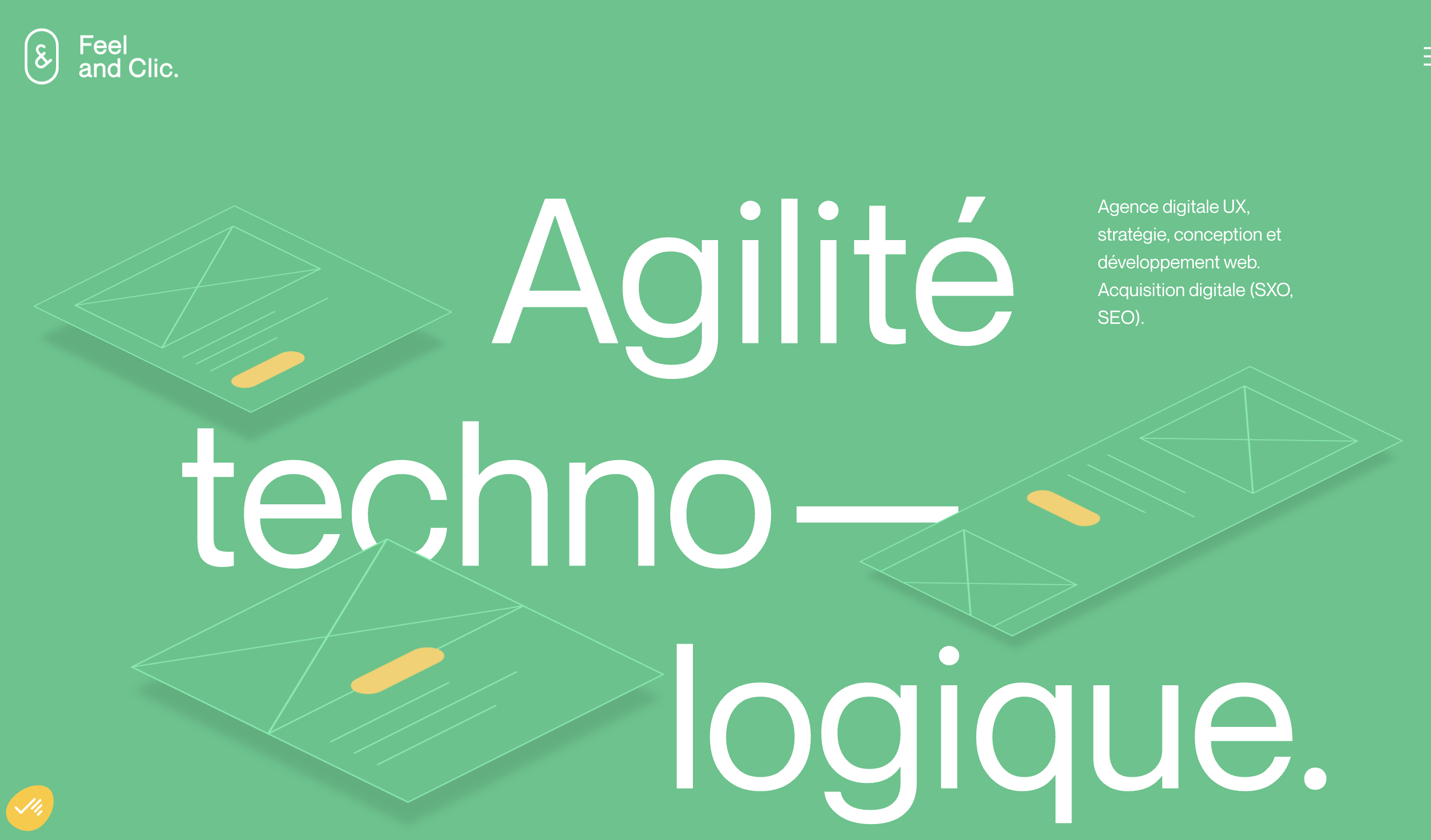
The Role of Screen Clicks in User Experience
The Significance of Clicks in Shaping User Journeys
In the realm of digital experience, every click on a screen represents a user's interaction with your platform. These clicks are not just random acts; they are critical data points that form the crux of user experience analytics. When users click on various elements within a website or app, they reveal valuable insights into their behavior, preferences, and pain points.
Understanding how users navigate through a digital product, whether it's a starting click on a homepage or an exit click on a landing page, provides designers with the opportunity to tailor the experience effectively. This dynamic process helps in configuring better layouts, optimizing user paths, and ultimately enhancing customer satisfaction.
Companies like Contentsquare have developed advanced platforms to harness this valuable information. By analyzing screen clicks, Contentsquare offers businesses the analytical tools to understand user interactions deeply. The rise of experience as a service in design is a testament to the importance of integrating click data into broader digital strategies. This integration allows for the creation of more personalized and satisfying digital experiences.
As user actions are documented and analyzed, session replays and the insights they provide can lead to significant product improvements. Platforms that specialize in experience platforms, like Contentsquare, and their integration with popular analytics services, such as Google Analytics, enable companies to offer more refined, customer-centric designs. This capability is crucial in today’s competitive market, where digital interactions can make or break customer loyalty.
Contentsquare's Approach to Screen Click Analysis
Decoding the Mechanism Behind Screen Clicks
In the complex landscape of digital experience analytics, screen clicks stand as pivotal indicators of user interaction with a website or app. Contentsquare has carved a niche in this domain by offering detailed analyses of these clicks, which are critical to understanding how users navigate through digital platforms. While many might rely solely on Google Analytics or similar tools, Contentsquare provides a deeper dive, focusing on the nuances of user behavior.
The platform collects and meticulously processes data to create a visual map of a user's journey, unraveling customer pain points and areas of high engagement. By examining each click, designers and UX professionals gain insights into how users interact with elements on a page, such as buttons and forms, influencing the customer experience.
This analysis isn't just about screen clicks themselves. Instead, it involves an exploration of how these clicks contribute to the broader user experience. With Contentsquare’s dynamic variables, session replays, and integration capabilities with third-party tools, businesses can pinpoint exactly where users get stuck or drop off. Such contentsquare integration helps in reducing friction points and improving user journeys. For those interested in delving deeper into the mechanisms of online site analysis, the understanding online site analysis for designers article provides an expansive view.
Contentsquare's approach extends beyond simple tracking. Leveraging advanced mechanisms, the platform provides a holistic view by integrating session replays, offering a powerful combination of empirical session data and actionable insights. Furthermore, businesses can configure their analyses, enabling them to understand both high-level patterns and specific dynamics within their user sessions. This approach, compared to tools like heap contentsquare, ensures a richer interpretation of click behavior.
Ultimately, the essence of Contentsquare's work lies in their ability to convert clicks into meaningful analytics, transforming raw data into strategies for enhancing the overall digital experiences that customers encounter. The invaluable insights provided inform strategic decisions that lead to more refined product designs, thereby directly impacting the product's success and customer satisfaction.
Leveraging Screen Click Data for Design Improvements
Unlocking Design Potential through Rich Click Data
In the digital sphere, user experience isn't static; it's a tapestry of dynamic interactions. As designers and businesses strive to craft top-notch digital experiences, leveraging rich click data from platforms like Contentsquare has become pivotal. The ability to analyze screen interactions provides profound insights, helping teams understand user intentions, preferences, and bottlenecks. Utilizing Contentsquare, the data gleaned from user sessions illuminates the nuanced behavior of users as they navigate through a website app or digital platform. By capturing each click, designers are equipped to identify key pain points that may hinder a customer’s journey. This process is further refined with session replays, which offer a visual of user interactions, turning abstract data into actionable insights. Integrating these analytics tools helps in the configuration of the user experience by allowing designers to view a session's culmination in a broader context. For instance, heatmaps and other experience analytics highlight which elements receive the most attention, often leveraging social proof to understand how users perceive the layout and navigation of a digital interface. The dynamic role that click data plays in refining user interactions is evident in numerous case studies. By configuring detailed reports and analysis, teams can enact informed design tweaks which improve not just the aesthetic appeal but the functional aspect, ensuring that each user touchpoint is as intuitive as possible. These improvements are not just hypothetical; they drive tangible business outcomes and heightened customer satisfaction. Ultimately, as platforms like Contentsquare continue to advance, the seamless integration with third-party tools such as Google Analytics can provide a more robust understanding of user behavior. This level of detail means user experience is continually optimized, balancing both quantitative data and qualitative feedback seamlessly. For more on creating responsive design and ensuring seamless user interactions, you can explore our detailed guide here.Challenges in Interpreting Screen Click Data
Complexities in Decoding Click Data
Understanding the intricacies of screen click data presents several challenges that require careful consideration. While Contentsquare provides profound insights into user behavior via analytics, interpreting this data demands both precision and context.- Dynamic User Behavior: Users' actions vary across digital platforms, influenced by a range of factors such as device type, session duration, and external circumstances. This fluidity complicates the standardization of data interpretation. A button click, for instance, could imply user satisfaction in one session but indicate frustration in another.
- Integrating With Other Tools: While platforms like Google Analytics and Contentsquare's experience analytics offer valuable insights, the integration and comparison of data sets from multiple tools can lead to discrepancies and require meticulous analysis. Platforms like Heap Contentsquare and others need to be configured correctly to align datasets fully.
- Contextual Interpretations: Not every click is self-explanatory. Determining the intent behind clicks demands an understanding of the broader session replay. Customers might click on various elements out of curiosity rather than intent, especially when a digital experience is particularly novel or complex.
- Analyzing Social Proof Impact: Social proof, such as user reviews and testimonials within a digital environment, can significantly influence click behavior. Disentangling its impact requires a combination of experience analytics and customer feedback analysis.
- Third-Party Integration Challenges: Collaborating with third-party tools provides comprehensive user insights but may introduce data interpretation glitches. For instance, screen recordings from session replays must align with click data from Contentsquare sessions to paint a coherent picture.
Case Studies: Successful Design Tweaks from Screen Click Insights
Demonstrating Effective Modifications Through Screen Click Insights
Screen click analysis serves as a potent tool for revealing enhancements that considerably amplify user experience. By leveraging click data analytics, several industries have transformed digital experiences into smooth and intuitive journeys for their users.
One instance stands out when a digital platform utilized Contentsquare’s session replay to discern unnecessary steps in their purchase workflow. By analyzing user screen interactions, the team configured the user path, subsequently reducing pain points for their customers and simplifying the buying process. The optimization led to increased conversion rates and improved overall customer satisfaction.
In another scenario, an experience platform turned to Contentsquare integration to evaluate dynamic variables on their website app. The goal was to enhance navigation and elevate the customer's journey by focusing on frequently clicked areas. By efficiently reallocating digital resources, the platform ensured that its users had easy access to key actions, leading to a significant increase in user retention and engagement.
Moreover, screen click analysis can often show where third-party integrations may drag down performance. A compelling example is a company that identified a friction point through Contentsquare session replays, which helped them refine integration points and enhance the seamlessness of their digital experience. As a result, their website became more responsive, with users experiencing fewer disruptions during crucial browsing sessions.
These cases underscore the significant influence contentsquare's detailed analytics have on driving user-centric designs. When platforms attentively address user interactions—capturing data-driven insights—they can make informed decisions that resonate with customer needs, fostering long-term satisfaction and loyalty.
Future Trends in Screen Click Analysis and Design
Emerging Technologies and Their Impact on Click Analysis
As digital experiences continue to evolve, the integration of emerging technologies is reshaping how we approach screen click analysis. The growing sophistication of experience analytics platforms like Contentsquare is enabling more nuanced insights into user behavior. This evolution is driven by the need to understand dynamic interactions and enhance the overall customer experience.
One significant trend is the use of artificial intelligence and machine learning to process and interpret click data. These technologies allow for more accurate predictions of user behavior, helping designers to configure products that better meet user needs. By analyzing patterns in click data, AI can identify pain points and suggest actionable improvements.
Integration with Other Analytics Tools
The future of screen click analysis also involves seamless integration with other analytics platforms, such as Google Analytics and Heap. This integration allows for a more comprehensive view of the user journey, combining click data with other metrics to provide a holistic understanding of digital experiences. By leveraging data from multiple sources, businesses can create more personalized and effective user experiences.
Contentsquare's platform, for instance, offers robust integration capabilities that enhance the depth of session replays and click data analysis. This integration not only improves the accuracy of insights but also streamlines the process of implementing design changes based on user feedback.
Focus on Real-Time Data and User Privacy
Real-time data analysis is becoming increasingly important in understanding user interactions as they happen. This immediate feedback loop allows for rapid iteration and optimization of digital experiences. However, with the rise of real-time analytics, there is also a growing emphasis on user privacy. Ensuring that click data is collected and analyzed in a way that respects user privacy is crucial for maintaining trust and compliance with regulations.
As we look to the future, the ability to balance the benefits of detailed click analysis with the need for privacy will be a key challenge for designers and analysts alike. The continued development of privacy-focused analytics tools will be essential in navigating this complex landscape.














